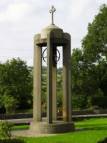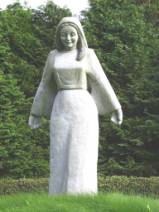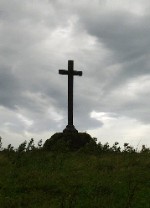
The present day church in Templeglantine was built in 1829, during Fr James Cleary's time as Parish Priest. At the time Templeglantine was part of Monagea. This is one of the oldest churches in the diocese that is still in use today. Incidentally, the year 1829 coincides with the granting of Catholic Emancipation to Irish Catholics under the leadership of Daniel O'Connell.
|
|
According to the inscription on the church wall, the church was dedicated to the Holy Trinity in 1829. The Baptismal font is presumed to date from 1829 also, as are the holy water fonts in the porch of the church. The porch itself was built in the 1930s following a donation received from parishioners who had emigrated to America.
According to local historian Tadhg O'Maolcatha, by the mid fifties, the church bell, which was mounted on the western gable was taken down for safety reasons, and housed in a new free-standing belfry in the church grounds. Mrs Bridget Kiely (nee Sexton) of Glenshesk donated the bell to the parish earlier in the century. The old bell, which it replaced, was sent to the missions in Africa.
 In front of the church there is a
large stone statue of the Virgin Mary that seems to be welcoming the people into
the church. This statue was erected in the summer of 1995 and depicts Mary as a
loving mother with head bowed and arms slightly outstretched in a welcoming and
caring manner. It was sculpted from Limestone and is the work of Newbridge
sculptor Annette McCormack.
In front of the church there is a
large stone statue of the Virgin Mary that seems to be welcoming the people into
the church. This statue was erected in the summer of 1995 and depicts Mary as a
loving mother with head bowed and arms slightly outstretched in a welcoming and
caring manner. It was sculpted from Limestone and is the work of Newbridge
sculptor Annette McCormack.
On the right of the
nave, there is a wooden medallion of the Holy Trinity. There is a statue to St
Patrick on the right while on the left there is a statue of St Theresa of Liseux.
A glass depiction of the Millennium Logo of the Diocese of Limerick is on a door
to the right of the altar. Behind the High Altar there is a stained glass window
of the Holy Spirit and the Body & Blood.
To the left of the altar there is a statue of St Joseph to the memory of John Dillane and family. On the right there is a statue of Mary and Child, which is to the memory of Mary (William) Dore and family. Daniel Dillane of New York donated both statues.
Within the church, the
Stations of the Cross date from around 1946 when they replaced the original
Stations of the Cross. The church also has a silver chalice that dates from
1796. Mr and Mrs Burke donated the chalice to the church. The Burkes may have
been from the parish of Monagea, as it was another 70 years before
Templeglantine parish came into existence.
There are two doors to enter the church. The door nearest the altar is locally
called the "Penny Door". It acquired this name because the seats in the church
were from this point forward and only those who could afford the princely sum of
one penny in the nineteenth century could sit in the seats. Most of the
congregation stood in the back of the church. The porch door was donated in
memory of Mrs Anne Connellan.
Westropp describes an old church ruin in Templeglantine. The site of this church is now surrounded by Templeglantine graveyard. The east end of the church was levelled before 1840. The remainder of the church was defaced and overgrown with ash and thorn. The walls of the church were about 6 or 7 feet in height, according to Westropp. While the ruins of the church no longer exist, a small wall has been built to show the site of the west gable of the church. The church was originally about 70 feet by 30 feet.
According to Tadhg O'Maolcatha, there was a thatched Mass House at Roche's Cross in Meenoline prior to 1829. Earlier still there was an Abbey in Templeglantine West.
There are two graveyards in the parish of Templeglantine. A new graveyard was opened behind the church in Templeglantine in September 1983.
Before that, the only graveyard in the parish had been in the grounds of the old church in Templeglantine West. Many Tournafulla families had their burial plots here. Burials still take place in this graveyard. It is believed that the graveyard has been in use for around 800 years. The oldest headstone that we came across dated from 1866 and was in memory of Michael Gallwey RM.
There are a number of interesting headstones here of a Celtic cross design. The four gaps between the circle of the arms of the Celtic cross are filled in with green glass. This form of headstone is the work of Mossy Wrenn who was a local man.
It is thought that there was a tomb to the de Lacy's in the grounds of the church but its exact location is unknown.
The largest headstone in the
graveyard commemorates Liam Scully, an IRA captain during the War of
Independence. Scully was killed in a raid on the barracks in Kilmallock on the
night of May 28th 1920. Due to the wartime situation, he could not be buried in
his home of Glencarr of Co. Kerry. Scully was waked locally and then, with only
a few local volunteers to assist in the burial, Liam Scully was buried at
midnight to avoid the attention of the Black and Tans. The headstone was erected
a few years later.
In the far corner of the graveyard lies a small headstone to the memory of Nellie Doody. People in West Limerick to this day regard Nellie, who was born in Tournafulla, as a holy woman. Many come to her grave seeking help or guidance in their lives. It has become a common practice to leave money under the pink flowerpot at her grave as an offering.
Nellie spent her life visiting churches and holy wells. She would often invite friends or the schoolchildren on their way home to come with her to say the Rosary. In the neighbouring parish of Monagea, we came across a story about a man who gave Nellie a lift in his car. She told him that she was going into St Brigid's Well in Shangarry in Newcastlewest, and asked him to wait for her. After a while the driver became impatient and he attempted to start the car. However hard he tried, the car would not move. When Nellie returned to the car, the driver again tried to start the car and on the first turn of the key, the car roared into life.

Templeglantine Mass Cross
According to Tadhg O'Maolcatha, there is a mass rock dating from penal times situated on the bank of a little stream that divides the townlands of Meenoline North and Doonakenna. The last mass to be said at the Mass Rock in Carraig an Easpaig was in 1989.
According to local folklore Dr Lacy, Bishop of Limerick from 1737 until 1759 celebrated mass in this secluded glen during Penal days. It is believed that his predecessor Bishop Cornelius O'Keeffe (1720-1737), whose family lived in Doonakenna, also celebrated mass at Carraig an Easpaig. In 1950 Bishop O'Neill unveiled a plaque at the rock in commemoration of the Holy Year. In the same year, a cross was placed on Cnoc an Bhothaigh near the site of the Mass Rock.
There are two Holy Wells in the parish, the Poorman's Well (Tobairín an Duine Bhoicht) and the Hapenny Well. The Poorman's well is situated beside the border of the parishes of Abbeyfeale and Templeglantine in the town land of Tulligoline North. A flowing stream, which is unnamed, divides the parishes. While no public devotions have taken place in the last twenty years or so, Toberreenadinnabocht is still visited by locals privately. Rounds used to be made here in May.
A poor old man dreamed that he would be cured of blindness here. He visited the well, and was cured, thus giving the well its name. It was claimed that the water could cure blindness. Another legend recounted by Danaher claims that two cloaked women could be seen at the well before dawn. People still draw water from the well in times of drought and it is claimed that the well has never run dry.
The Ha'penny Well (Tobereenalaffina) is very small well located on the Northern bank of the Eaghaun stream on the lands of the O'Donnell family of Meenyline South. According to Danaher legends surrounding the well claim that its water can cure blindness, and that a blind man dreamed he would be cured at the well and soon after he was. Flowers and coins used to be left here as offerings in the past. Devotions are no longer held here.